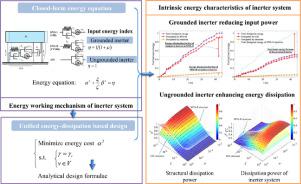当前位置:
X-MOL 学术
›
Int. J. Mech. Sci.
›
论文详情
Our official English website, www.x-mol.net, welcomes your
feedback! (Note: you will need to create a separate account there.)
Input energy reduction and energy dissipation enhancement mechanism of inerter systems
International Journal of Mechanical Sciences ( IF 7.1 ) Pub Date : 2020-10-01 , DOI: 10.1016/j.ijmecsci.2020.105845 Zhipeng Zhao , Qingjun Chen , Ruifu Zhang , Chao Pan , Yiyao Jiang
International Journal of Mechanical Sciences ( IF 7.1 ) Pub Date : 2020-10-01 , DOI: 10.1016/j.ijmecsci.2020.105845 Zhipeng Zhao , Qingjun Chen , Ruifu Zhang , Chao Pan , Yiyao Jiang

|
Abstract Inerter systems have been proven to be effective vibration control devices. The energy-input-dissipation flow offers an alternative perspective to reveal the working mechanism of inerter-based systems for vibration control. In this study, the energy-based method is used to analytically explain the discovered benefits of inerter systems including the reduction in input energy and the enhancement of energy dissipation, which further yields optimal design for the inerter systems. Closed-form energy equations are derived for structures equipped with a basic inerter system composed of a grounded or ungrounded inerter. These energy equations theoretically establish the quantified relationship between the powers of input and dissipation and the key parameters of the inerter system in an analytical form. Furthermore, the differences in working mechanisms between inerter systems composed of grounded or ungrounded inerters are characterized via comparative analysis in terms of the displacement control, enhanced energy dissipation efficiency, and input energy reduction. Based on the revealed energy working basis, a unified energy-dissipation-based optimization strategy is developed to simultaneously control the displacement and energy responses. Finally, numerical examples are presented to validate the derived energy equations and the proposed optimization strategy. The findings of this study show that the energy equation supplies an analytical measurement for evaluating the input power of inerter-based structures and quantifies the energy dissipation effect of the inerter system. In particular, the derived energy equation explicitly reveals the dual benefits of an inerter system with a grounded inerter, which reduces the input power of the entire inerter-based structure and simultaneously dissipates the vibrational energy. Following the energy-dissipation-based optimal design strategy, which directly applies the grounded inerter to reduce input power or potentially uses the ungrounded inerter to enhance the energy dissipation effect, the target displacement can be quantitively achieved by the optimized inerter systems.
中文翻译:

惰性系统的输入能量降低和能量耗散增强机制
摘要 惯性系统已被证明是有效的振动控制装置。能量输入耗散流为揭示基于惯性的振动控制系统的工作机制提供了另一种视角。在这项研究中,基于能量的方法用于分析解释惰性系统的已发现好处,包括输入能量的减少和能量耗散的增强,这进一步产生了惰性系统的优化设计。对于配备有由接地或未接地惰性材料组成的基本惰性材料系统的结构,可以推导出闭合形式的能量方程。这些能量方程在理论上建立了输入功率和耗散功率与惰性系统关键参数之间的量化关系,并以分析形式存在。此外,通过对排量控制、提高能量耗散效率和输入能量降低等方面的比较分析,表征了由接地和不接地惰化器组成的惰化系统之间工作机制的差异。基于揭示的能量工作基础,开发了统一的基于能量耗散的优化策略,以同时控制位移和能量响应。最后,给出了数值例子来验证导出的能量方程和所提出的优化策略。这项研究的结果表明,能量方程为评估惰性结构的输入功率提供了一种分析测量,并量化了惰性系统的能量耗散效应。特别是,推导出的能量方程明确揭示了惰性系统与接地惰性系统的双重好处,它降低了整个基于惰性的结构的输入功率,同时消散了振动能量。遵循基于能量耗散的优化设计策略,即直接应用接地的惰轮来降低输入功率或潜在地使用不接地的惰轮来增强能量耗散效果,通过优化的惰轮系统可以量化地实现目标位移。
更新日期:2020-10-01
中文翻译:

惰性系统的输入能量降低和能量耗散增强机制
摘要 惯性系统已被证明是有效的振动控制装置。能量输入耗散流为揭示基于惯性的振动控制系统的工作机制提供了另一种视角。在这项研究中,基于能量的方法用于分析解释惰性系统的已发现好处,包括输入能量的减少和能量耗散的增强,这进一步产生了惰性系统的优化设计。对于配备有由接地或未接地惰性材料组成的基本惰性材料系统的结构,可以推导出闭合形式的能量方程。这些能量方程在理论上建立了输入功率和耗散功率与惰性系统关键参数之间的量化关系,并以分析形式存在。此外,通过对排量控制、提高能量耗散效率和输入能量降低等方面的比较分析,表征了由接地和不接地惰化器组成的惰化系统之间工作机制的差异。基于揭示的能量工作基础,开发了统一的基于能量耗散的优化策略,以同时控制位移和能量响应。最后,给出了数值例子来验证导出的能量方程和所提出的优化策略。这项研究的结果表明,能量方程为评估惰性结构的输入功率提供了一种分析测量,并量化了惰性系统的能量耗散效应。特别是,推导出的能量方程明确揭示了惰性系统与接地惰性系统的双重好处,它降低了整个基于惰性的结构的输入功率,同时消散了振动能量。遵循基于能量耗散的优化设计策略,即直接应用接地的惰轮来降低输入功率或潜在地使用不接地的惰轮来增强能量耗散效果,通过优化的惰轮系统可以量化地实现目标位移。















































 京公网安备 11010802027423号
京公网安备 11010802027423号